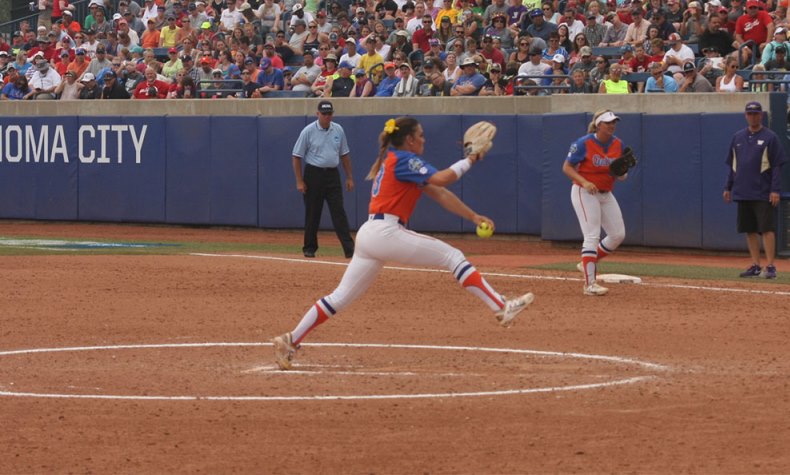Softball pitchers tend to rely on a variety of pitching techniques and types. This helps them confuse the batter and gain the upper hand. This also helps them slow down or confuse the batter’s hits, effectively turning the scales in favor of their own team.
Some of the most popular softball pitches include fastball and drop ball. Typically, a pitcher is asked to start practicing a drop ball only after she has perfected the fastball. This is because the fastball mostly requires a greater pitching speed whereas the drop ball requires not just speed but also a carefully controlled direction. So once a pitcher has mastered the fastball, it is relatively easier to move on to drop ball and master it as well.

The unique feature of a drop ball is that it starts to sink as it moves towards the batter. This makes it harder for a batter to hit the softball effectively, altogether missing it in many cases. Even if the batter is able to hit a drop ball, the hit is not very effective. As a result, drop ball pitching is very useful in gaining groundball outs. The more effective a drop ball, the more it dips just as it moves towards the batter.
The key feature of a drop ball is that it relies on the mid-air movement of the ball during its flight from the pitcher to the batter. So when a pitcher starts to throw a drop ball, she is able to manipulate not just the speed and location of a softball but also its movement during the flight.
Why use pitching softball drop ball?
A softball drop ball is most commonly used to confuse the hitter. A drop ball is significantly harder to hit compared to a straight pitch. This is why when you throw a drop ball, the batter has a harder time dealing with it.
Most pitchers mix up drop balls, fastballs and changeups when throwing their pitches. As a result, the batter is never able to anticipate exactly what type of pitch she is going to face. This leads to many strikes and helps the pitcher gain the upper hand.
Drop balls are particularly useful in dealing with such hitters who can hit straight pitches powerfully. When you manipulate ball movement in a drop ball pitch, the batter is no longer able to channel the hitting energy directly into the ball. Instead, she also has to read the ball’s movement and adapt to it. So drop balls serve as a great stopgap to slow down the batters of the opponent team.
The ways to have a perfect pitching softball drop ball?
There are many ways and techniques of throwing a drop ball. Some of these techniques are meant for beginners as they are less strenuous and require a lesser degree of skill. Others are more advanced techniques and produce more effective drop balls, but these require rigorous practice.
Simple Drop
When throwing a drop ball, the purpose of your pitch should be to throw a ball at high speed so that it dips and sinks as it reaches the batter. The simplest way to do this is to execute a simple drop movement. This movement requires you to grip the softball along the seams. Swing back the arm to bring the ball at your shoulder’s height. Now, begin the forward motion of the throw while taking a short step at the same time. Just as you release the softball, make sure that you pull your arm back. This creates a sort of opposite movement and causes the ball to dip as it moves away from you.
Peel Drop
Although somewhat difficult, this is a more common way of executing a drop ball. The peel drop results in highly effective drop balls that approach the hitter at a dipping angle and great speeds.
Compared to a simple drop or a fastball, a peel drop is the kind of pitch which requires you to throw the drop ball within a smaller stride space. Because of the smaller stride, the pitch is more effective.
To execute the peel drop movement, simply reduce the length of the stride so that it is only 6 to 12 inches long. At the same time, make sure that when you release the softball, you sharply pull back your arm. The sharp pull-back, the small stride and the greater speed ensure that the softball sinks more acutely during a peel drop.
An important point to consider is that the pitcher must let the ball roll off her fingers when releasing it. The more effectively this movement is executed, the more spin is added to the ball’s movement. This spin, alongside the speed and the arm movement, ensures that the ball sinks when moving towards the plate.
Rollover Drop
Another technique used in executing an effective drop ball is the rollover drop. To perform the rollover drop, hold the ball along the seams where the seams are the narrowest. The stride size in a rollover drop is 6 to inches, similar to the peel drop movement. However, the arm movement is somewhat different.
To execute the rollover drop, swing your arm back and take a short step towards the plate. As you do so, you must shift the weight to the front leg. Now, as you release the softball, make sure you snap the wrist so that it rotates towards your inner hip. This movement ensures that once you have delivered the pitch, your pitching hand is positioned so that the thumb points towards the ground while the little finger is pointing towards the hitter.
Mastering the wrist snap is the key to a good rollover drop. If you execute the wrist movement perfectly, it will result in an exceptional degree of ball drop. As a result, a well-executed rollover drop movement can lead to pitches which are incredibly hard to hit for the batters.

Hello everyone, I’m Darron and head Editor of this site. I’m so proud to be a part of this project.
